1/32 P-40L Warhawk
This is the Hasegawa 1/32 P-40 (actually the "Kittyhawk III/P-40M" iteration) with the Greymatter Figures conversion for the Merlin engined P-40. Zotz decals.
The model currently resides in the home of the real "Duchess of Durham."
In an effort to improve the performance of the P-40 above 15,000 feet, Curtiss decided to replace the 1,200 h.p. V-1710 Allison and its single-stage, single‑speed supercharger, with a Packard V‑1650 Merlin producing 1,300 h.p. and using a single-stage, two-speed supercharger. A Rolls‑Royce Merlin engine was first installed in a P‑40D to produce the XP‑40F, which flew on October 23, 1941. The production P‑40F Warhawk, became the first American fighter to use the Packard Merlin; with a top speed of 364 mph, the P‑40F was 10 mph faster than the P‑40E with an increase in altitude performance, though not as much as had been hoped for. The major external difference between the P‑40E and P-40F was the absence of the upper air scoop on the P‑40F cowling, though there were additional differences in the radiator ducting and exhaust, due to the Merlin's updraft carburetor. 1,311 P‑40F Warhawks were built during 1942, along with 700 similar but lighter‑weight P‑40L Warhawks produced through early 1943. The P-40F-1 had the short fuselage of the P-40E, while the P-40F-5 and all following utilized the long-tail fuselage introduced in the P-40K-5. When the supply of P‑40F and L airframes outstripped the supply of Packard Merlins early in 1943, 600 were completed with Allison engines; designated P‑40R, they were used as fighter trainers.
The RAF received approximately 100 P-40F Warhawks, which were designated “Kittyhawk II.” While the majority of P-40F and P-40L Warhawks served with the USAAF in the Mediterranean Theater, some were also sent to the Solomons, where they equipped the 18th Fighter Group for a short time in early 1943. The Merlin Warhawks finally left first-line service in the Italian Theater during the spring of 1944, when they were replaced in the fighter-bomber role by the P-47 Thunderbolt.
The 325th Fighter Group:
The 325th Fighter Group, composed of the 317th, 318th, and 319th Fighter Squadrons, was activated August 3, 1942, at Mitchell Field, New York. The unit moved to Providence, Rhode Island at the end of the month to train for overseas combat, then transferred to Langley Field, Virginia, on January 2, 1943, where they were equipped with new Merlin-powered P-40F Warhawks and spent several days training to launch from an aircraft carrier.
On January 7, 1943, the group flew to Norfolk, Virginia, where they went aboard USS Ranger, for transit to North Africa. They arrived off Casablanca on January 18, and were launched from Ranger on the 19th, flying to their base at Tafaraoui, Algeria.
The 317th Fighter Squadron flew the group's first combat mission on April 17, 1943, escorting B-25 Mitchells attacking German positions in the Mareth Line in Tunisia.
In late May, 1943, following the surrender of Axis forces in North Africa, the 325th FG participated in the campaign against the island of Pantelleria, during which they became the first P-40s to carry 1,000-lb bombs on dive-bombing missions. During the campaign, the 325th FG flew 33 missions totaling 652 sorties, with 16 missions flown in one five-day period. At the height of the campaign, 6 missions were flown in one day. These missions included dive-combing, strafing, and bomber escort.
Following the surrender of Pantelleria - the only enemy base to surrender to an air campaign during the war - the 325th FG moved to the island and began operations against Sicily in late June, 1943. At this time, they began painting the tails of the P-40F and P-40L Warhawks with yellow and black checker markings, and became known as “The Checkertail Clan.”
During the air campaign in July and August 1943 over Sicily and Sardinia, the 325th FG flew several spectacular missions, including one where they destroyed 12 seaplanes and damaged another 6 at the Stagnono Anchorage in Sicily. In another, the 317th and 318th Fighter Squadrons destroyed 17 out of 25 enemy aircraft encountered over southern Sardinia.
On July 30, 1943, 20 P-40s of the 317th FS, and 16 of the 319th FS, flew a fighter sweep over Sardinia. Over Sassari, the 317th FS was attacked by 25-30 Bf-109s and approximately 18-20 C.202s just before they were to rendezvous with the 319th FS. In the brief, intense battle, the 20 P‑40s engaged and destroyed 21 enemy aircraft, with 4 probables.
Four pilots of 317th Fighter Squadron became aces flying the P-40F and P-40L, including Captain Ralph G. “Zack” Taylor Jr., who scored his fourth, fifth and sixth victories in the battle of July 30, to become the squadron's leading ace. His aircraft was the well-known “Duchess of Durham.”
By the end of the Sicilian Campaign on August 17, 1943, the 325th FG had flown 3,233 sorties during 110 missions, shot down 128 enemy aircraft for a loss of 26 P‑40s, and escorted 1,100 bombers without loss to enemy air action, during four months of combat.
At the end of September, 1943, the 325th Fighter Group gave up their Warhawks and transitioned to P-47 Thunderbolts, leaving the 12th Air Force to become strategic escort fighters in the newly-formed 15th Air Force. The group went on to also fly the P-51 Mustang from May, 1944, making them one of very few fighter groups to fly three of the four major USAAF fighters of the war. Among their many later achievements was flying the first Italy-Russia shuttle mission in June 1944.
THE KIT
Hasegawa has released kits of every Allison-powered P-40, but has yet to produce the Merlin P-40 in any scale. In 1/48, this problem could be solved by the use of a resin nose produced by AMTech to correct their release of the AMT P-40F. In 1/32, the lack of a Merlin P-40 has now been taken care of by Greymatter Conversions, with the arrival of their eagerly-awaited conversion set.
Designed by Derek Bradshaw of BAC, this is the only 1/32 conversion for the Merlin P-40 that accurately portrays the radiator ducting and exhaust (which is one reason why the set was delayed several months while this was researched).
The conversion set can be used to create either an early short-tail P-40F, or an early long-tail P-40F or the late-production P-40L, which is primarily distinguished by the small window in the left windshield quarter panel. Greymatter Figures has also produced a resin “long tail” replacement for those modelers who cannot find the P-40M kit and end up using the P-40E kit.
The best Hasegawa kit to use for the conversion is the “Kittyhawk I/III” release, which includes the two different windscreens, the two different tails, and the two different sets of exhaust, allowing a modeler to do any Merlin P-40 version they desire. This was a limited-run kit, so you may have to look around to find one if you didn't get hold of it right off (in 2021, it's a rare collector's kit).
Zotz Decals also released ZTZ32-035, “North African Warhawks,” in cooperation with Greymatter, to provide markings for six different P-40F and P-40L Warhawks, including a short-tail P-40F from the 78th Fighter Group, an early P-40F transferred to G.C.II/5 “Lafayette Escadrille” of the French Air Force, a P-40L of the 325th Fighter Group, and a P-40L of the 324th Fighter Group. All are in desert camouflage.
Construction:
The conversion set is designed to allow a modeler to cut away the plastic engine cowling along panel lines, and replace it directly with the resin replacement. This comes in two main parts - the engine cowling and the radiator cowling - along with the radiator parts, the cowling intake and the cowling flaps with their associated control linkages.
After cutting off the nose of each forward fuselage half, I then attached the long-tail rear fuselage part to each forward fuselage part before proceeding. I then glued the fuselage halves together, and then attached the resin replacement parts. Any modeler who has done this sort of modification surgery to a kit before should have no problem doing this, thanks to the very clear drawings included in the instructions that come with the conversion set.
While the fuselage sub-assembly was setting up, I assembled the wing.
I then painted the cockpit, assembled it, and installed it in the fuselage. I finished off by assembling the fuselage and wing, and attaching the horizontal stabilizers.
I then found I needed to apply some putty to the upper area of the resin cowling attachment to the fuselage to get a smooth fit. When that was done, I filled all the seams and joints with Tamiya's version of “Mr. Surfacer.” I sanded everything smooth and then rescribed panel lines where necessary.
Painting:
I used Gunze-Sangyo “Dark Earth” and “Middle Stone,” and Xtracrylix “Azure Blue.” There has been much discussion over the years about whether the Merlin P-40s in the Mediterranean used Azure Blue or Neutral Grey. I have Jeff Ethell's “World War II In Color” series, and there are several photos of P-40Ls in Volume 2 which clearly show that at least the late production Merlin P-40 did use Azure Blue.
I followed the instructions for doing “Duchess of Durham,” with the replacement Olive Drab/Neutral Grey lower cowling. I painted that, masked it off, then freehanded the rest of the camouflage scheme according to the painting diagram supplied in the Zotz sheet, going back over each upper surface color to get various levels of sun-fading by adding light grey and white to the mixtures. I finished off with a coat of Future.
Decals:
The Zotz decals went on without problem, though I did have to slice along the control surface separation lines with the Checkertail decals to get them to set down completely. I used the kit decals from a P-40E for the wing national insignia, because the blue in those markings was a lighter shade that did a good simulation of sun-fading.
Final Construction:
I gave the model several coats of Xtracrylix Flat varnish, with some Tamiya “Flat Base” added in to get the dead-flat sun-faded finish seen on North African-based aircraft. I then attached the landing gear and prop, and the separate exhaust stacks. Exhaust stains were done with Tamiya “smoke” and some “dinging” to match the photos I found of the 1:1 “Duchess of Durham” flown by Captain Ralph G. “Zack” Taylor Jr., the 317th FS leading ace. I finished off by unmasking the cockpit glass and attaching the canopy in the open position.
Conclusions:
I really don't know why Hasegawa hasn't done a Merlin P-40 in their series. Perhaps they couldn't find that detail information Derek Bradshaw had to search out for so long. This is an easy conversion for anyone with experience of kit conversions, and the result is a great-looking model that pretty much finishes off the major versions of the P-40 Warhawk series. Highly recommended.
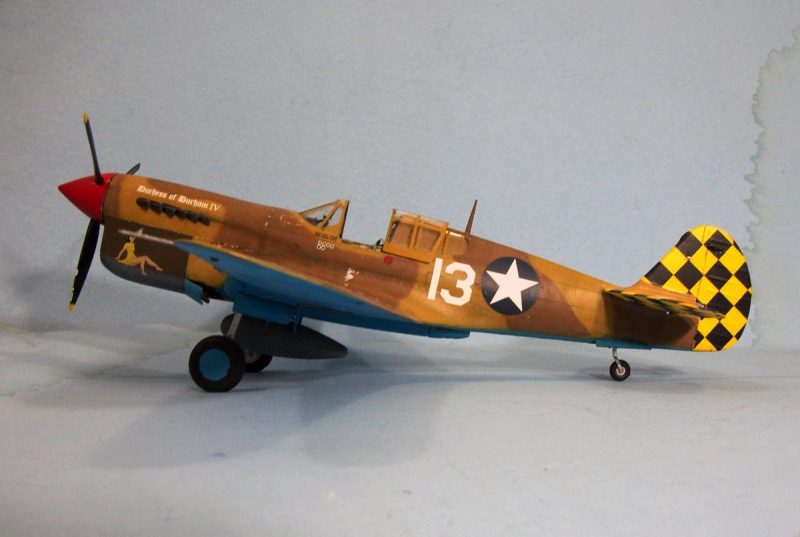
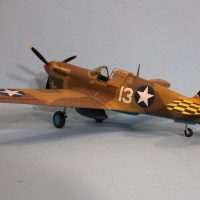
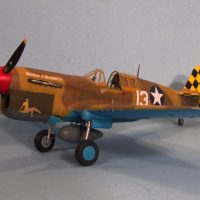
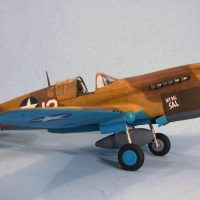
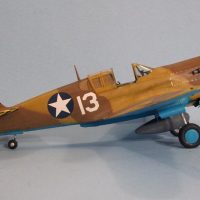
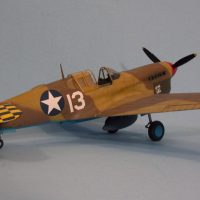
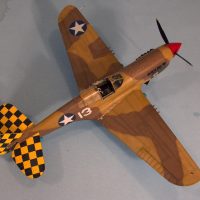
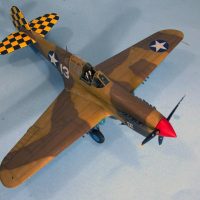
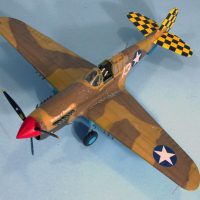
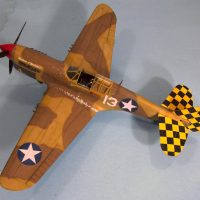
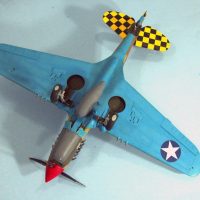
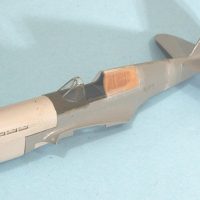
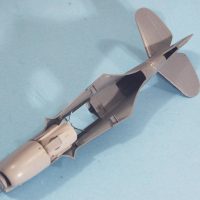
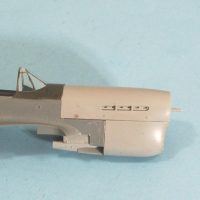
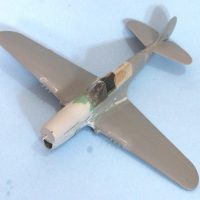
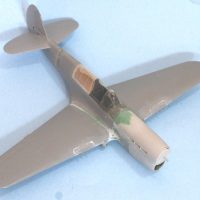
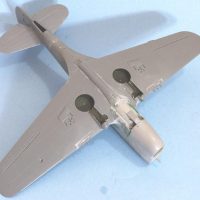
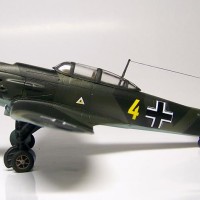
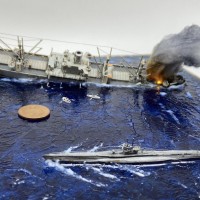

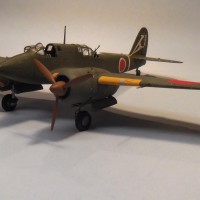
Lovely !
So many cool markings for P-40's
Tail painted or stickies?. Great looking build.
The tail is decals for the black squares. Always take the easy way out whenever offered.